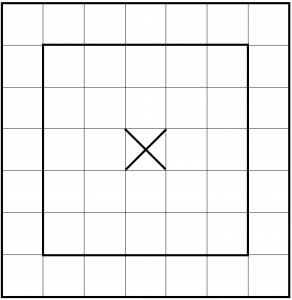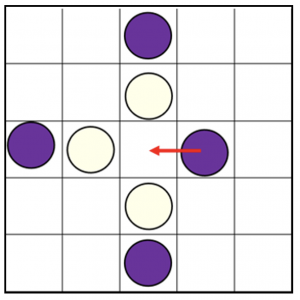Seega
Start with the easiest version on a 25 square board each player having 12 men (coloured counters). Then graduate to boards with 49 or 81 squares and 24 or 40 men each. Either 25 or 49 squares can be used on the board shown. Aim to set traps to capture your opponent’s pieces and to create barriers that your opponent cannot move across.
 STAGE 1: In turn, put 2 of your men on the board but not on the centre square, until all the men (pieces) have been placed.
STAGE 1: In turn, put 2 of your men on the board but not on the centre square, until all the men (pieces) have been placed.
STAGE 2: Player 1 moves one of his men to the centre square, if unable to do so removing one of the opponent’s men. In turn move one of your men horizontally or vertically, not diagonally. They cannot jump over other men. To capture a man, place 2 of your men, one on either side of one of your opponent’s men (horizontally or vertically). If a player puts a man between two opponent’s men, nothing happens. After a capture, you can move again if that results in another capture. To win you must capture all your opponent’s pieces.
 Purple can capture three of Cream’s pieces at the same time by moving the piece as shown by the arrow.
Purple can capture three of Cream’s pieces at the same time by moving the piece as shown by the arrow.
Cream can capture one of Purple’s pieces by moving the piece as shown by the arrow.
VARIATIONS You can change the Stage 2 starting rule so that, if Player 1 cannot move a piece to the centre, then Player 2 has two turns. In another variation, the player that can’t make a move, can force their opponent to remove a piece that will allow the player to make a move.
In some versions of Seega, the game is over when one player has only one piece left. In others, the game is only over when one player has lost their final piece.
 JUMP (also called BLOCK) starts with this layout. The men (pieces) are moved singly, one space at a time horizontally or vertically, but never diagonally. Captures are made in single or multiple jumps over opposing men and not as for Seega. It is not obligatory to make a capture every time it would be possible.
JUMP (also called BLOCK) starts with this layout. The men (pieces) are moved singly, one space at a time horizontally or vertically, but never diagonally. Captures are made in single or multiple jumps over opposing men and not as for Seega. It is not obligatory to make a capture every time it would be possible.
 DEERAH is another game for 2 players on a 6 by 7 board. Each player has 12 men (pieces) in a distinctive colour. They take turns to place one of their men on the board until all are in play. At each turn after that they move one man one square, but not diagonally. The aim is to make lines of 3 either horizontally or vertically, removing an enemy piece each time they make a line. Lines formed during the initial phase of placing men on the board do not count, nor do lines of any other number of men. The winner is the player who makes it impossible for the opponent to make another line of three. This game is popular in Africa, especially in Nigeria.
DEERAH is another game for 2 players on a 6 by 7 board. Each player has 12 men (pieces) in a distinctive colour. They take turns to place one of their men on the board until all are in play. At each turn after that they move one man one square, but not diagonally. The aim is to make lines of 3 either horizontally or vertically, removing an enemy piece each time they make a line. Lines formed during the initial phase of placing men on the board do not count, nor do lines of any other number of men. The winner is the player who makes it impossible for the opponent to make another line of three. This game is popular in Africa, especially in Nigeria.
Click here to download the SEEGA worksheet
Click here to download the SEEGA Notes for Teachers
Click here to download gameboards for SEEGA, JUMP and DERRAH
Click here to download the SEEGA poster
South Africa COVID-19 News
Here is the official website for COVID-19 updates.
Login
SUPPORT AIMSSEC






